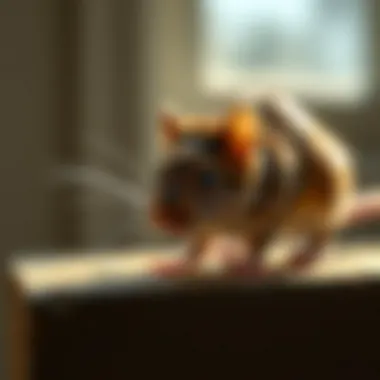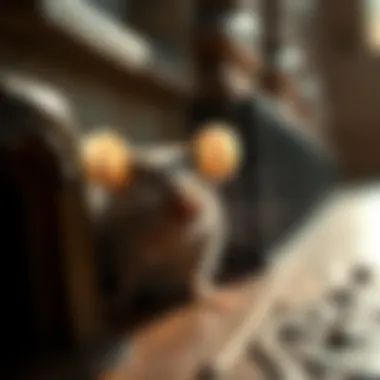Understanding Rodent Intrusions in Your Home


Intro
Rodents, particularly mice and rats, have been unwanted guests in homes for centuries. Their ability to adapt to changing environments often leads them straight into our living spaces. As homeowners and caretakers, we must be aware of the signs of rodent activity, understand their behaviors, and develop effective strategies for managing these intrusions. This guide aims to equip housewives and homeowners with essential knowledge about these pests to ensure a safe and comfortable living environment.
Understanding Pests
Definition of Pests
When we talk about pests, we generally refer to animals that interfere with human activities, harming crops, structures, or health. Mice and rats fall squarely into that category. Mice are typically small, often gray or brown, with long tails and large ears. Rats, on the other hand, are larger, with a more robust body and longer tails, presenting a different set of challenges in terms of management.
Importance of Pest Identification
Identifying whether you are dealing with a mouse or a rat is crucial. The behaviors, nesting patterns, and health risks associated with each species vary significantly. For instance, mice tend to be more curious and may venture more freely into a home, whereas rats tend to avoid open spaces and are more cautious.
Understanding their habits not only helps in identifying the species but also aids in devising effective control strategies. Recognizing their droppings or gnawing patterns is one way to ascertain their presence.
An informed homeowner is a proactive homeowner. Knowing the signs of rodent invasions ensures timely action, reducing health risks and property damage.
Prevention Techniques
Prevention is key when it comes to managing rodents in your home. Implementing thorough preventative measures can significantly lower the likelihood of an infestation.
Home and Garden Preventative Measures
Here are some strategies for keeping your home and garden rodent-free:
- Seal cracks and gaps in walls, around doors, and windows with caulk or steel wool.
- Store food in airtight containers, whether it's in the pantry or pet food.
- Keep the garden tidy; trimming bushes and removing debris can deter rodents.
- Ensure garbage is secured in containers with tight-fitting lids.
Seasonal Prevention Tips
Seasonal changes can invite rodent troubles.
- In fall, as temperatures drop, rodents seek warmth inside. Check for holes and gaps in home siding during this time.
- Winter months may encourage nesting in attics or basements, so keep these areas clean and free of clutter.
- During spring, be vigilant outside; clear any overgrown areas where rodents may nest.
Eco-Friendly Pest Control Solutions
For homeowners looking to manage rodent issues without harsh chemicals, eco-friendly approaches can be effective and safe.
Overview of Sustainable Practices
Utilizing natural deterrents and traps can minimize harm to the environment and pets. Consider methods like using peppermint oil as a natural repellent or sticky traps as a humane option.
Natural Remedies and Their Effectiveness
Some folks swear by essential oils; for example, peppermint oil has been noted for its effectiveness in repelling rodents. Spraying it around entry points might discourage them from entering. Another option could be the use of specific predators, such as owls, which can keep the rat population in check without direct harm to other wildlife.
For ideas on sustainable pest control, check out the discussion on Reddit.
Prolusion to Rodent Intrusions
Every household craves a sense of safety and security, but when unwelcome guests like mice and rats show up, that comfort can swiftly become a distant memory. Understanding rodent intrusions is critical not just for peace of mind but also for maintaining the health and safety of your home. This section aims to unpack the significance of recognizing the distinct species that may invade your space and the possible consequences that come with their presence.
Defining Mice and Rats
Mice and rats, while sharing a similar family tree, are actually quite different in characteristics and behaviors. House mice, for instance, typically measure between 2.5 to 4 inches in length (not counting their tails), showcasing a sleek body and relatively large ears. These little folks are usually light brown or grayish with a lighter underbelly.
On the other hand, we have the Norway rat, which can grow up to 9 inches long and has a more robust, stocky body. They prefer darker shades like brown or black and have blunt snouts alongside smaller ears. One might say, spotting a rat might feel like encountering a not-so-cute cousin of a mouse.
Understanding these differences can be crucial. The size, color, and even tail length can be telling indicators when deciding how to manage a potential rodent problem. Knowing which rodent is making a residence in your house helps tailor the response you might prefer, whether it be a traps or a more involved pest management approach.
Overview of Residential Rodent Issues
Residential rodent issues aren't just a matter of annoyance; they can lead to severe health risks and property damage. Rodents are notorious for carrying diseases that can be transmitted to humans. For instance, Hantavirus and Leptospirosis are names that might sound foreign, but they spell trouble for those living in compromised spaces. Their presence can exacerbate allergy symptoms too, causing havoc for those sensitive to the dander.
From a property standpoint, the ramifications can be equally daunting. These small creatures tend to chew through wires, insulation, and even wood, leading to potential structural issues and costly repairs.
Understanding these risks emphasizes why being informed about rodent intrusions is paramount for any homeowner. It's not merely a question of pest annoyance; it’s about safeguarding your family's health and ensuring the longevity of your home.
"Early detection and proactive measures can save you a whole lot of hassle and expense down the road."
By delving deeper into rodent identification and behavior, homeowners can equip themselves with the necessary tools to tackle these intrusions head-on.
Identifying Mice and Rats: Key Differences
Understanding the distinctions between mice and rats is essential for effective management of rodent intrusions in the home. The two species, while small and often confused, exhibit marked differences in physical appearance and behavior that can impact the methods used for control and prevention. In the following sections, we delve deeper into their physical characteristics and behavioral traits, which will aid homeowners in identifying which type of rodent they might be dealing with. This recognition is not just about taxonomy; it's crucial for strategizing effective remediation and safeguarding the household.
Physical Characteristics
Size and Weight Discrepancies
One of the most apparent differences between mice and rats is their size. House mice typically measure about 2.5 to 4 inches long, excluding the tail, and weigh around 1/2 to 1 ounce. In contrast, the common brown rat can grow to about 7 to 10 inches, weighing in at a hefty 10 to 18 ounces. This size difference isn't merely for aesthetics; it directly influences how each species interacts with your living spaces.
Key Characteristic: The sheer bulk of rats often leads to more significant damage as they navigate through homes, while smaller mice tend to squeeze into tighter spaces.
Mice, being lightweight, are more likely to go unnoticed until the damage has escalated. Their small size allows them to inhabit areas that might remain undetected, such as behind walls or beneath floorboards.
Color Variations
When it comes to color, house mice are usually found in shades of brown, gray, or even white, depending on the breeding. Brown rats, however, display a more muted color palette, often appearing as shades of brown or gray, but their underbellies tend to be lighter.
Key Characteristic: Color can sometimes serve as a quick identification tool. However, under different lighting or from a distance, these colors may not be definitive.
This characteristic could complicate efforts in spotting them quickly, making it important for homeowners to scrutinize physical traits beyond just color, as environmental factors can alter their appearances.
Tail Differences
The tails of mice and rats are also distinct. Mice possess long, thin tails that are roughly the same length as their bodies and are covered in fine hairs. Rats have thicker, scaly tails, often shorter in proportion to their bodies.
Key Characteristic: A rat's tail serves as a tool for balance and thermoregulation, while a mouse's tail is more about communication and sensory perception. Recognizing these tail differences offers another layer of identification that can play a role in managing infestations.
Behavioral Traits


Feeding Habits
Understanding the feeding habits of both mice and rats provides insight into their lifestyles and preferences, which can help inform control strategies. House mice tend to nibble at a variety of items such as grains and different types of foodstuffs, often feeding in small amounts throughout the day. In contrast, rats are more opportunistic feeders, consuming larger meals less frequently but with a broader diet, including meats and decomposed foods.
Key Characteristic: Rat feeding behavior often leads to quicker contamination of food sources due to their indiscriminate eating habits, making immediate action crucial if they are spotted.
Nesting Preferences
Mice usually prefer to nest in secluded areas, often inside walls or hidden corners, where they can remain undetected. Conversely, rats more commonly choose nesting sites close to food sources, often outdoors or in burrows.
Key Characteristic: Mice constructing nests with soft materials can create telltale signs in a home, whereas rats form larger nests that are noticeably messier. Recognizing these distinctions provides clarity in determining where to focus efforts for trapping and control.
Activity Patterns
The activity patterns of mice and rats also vary markedly. Mice are generally nocturnal and can be seen scurrying around during the night. On the other hand, rats can be more active during the early evening and early morning hours, often venturing out for food more visibly when it’s dark but not dead of night.
Key Characteristic: This knowledge of activity patterns can help homeowners know when to set traps or prepare defenses, ensuring a more effective strategy against these intruders.
Potential Risks of Rodent Infestations
Addressing rodent infestations isn't just about unwelcome guests; it’s about recognizing the serious risks they bring into our homes. The presence of mice or rats creates a chain reaction of potential health issues, property destruction, and emotional stress. When one sees a rodent scurry across the floor, it's not just a fleeting moment of surprise – it could signal underlying dangers that extend far beyond the immediate sighting. Ignoring these risks can lead to substantial long-term consequences, both physically and financially.
Health Risks to Humans
Zoonotic Diseases
Zoonotic diseases are infections that can be transmitted from animals to humans. In the case of rodents, these can include hantavirus, leptospirosis, and lymphocytic choriomeningitis (LCMV). Each of these diseases can lead to serious health issues if not addressed. The unique aspect of zoonotic diseases is their capability to proliferate in densely populated areas, where rodents thrive.
One particularly concerning feature is their resilience; when conditions are right, some of these pathogens can survive for days in rodent waste. This longevity means that even after the rodents are gone, the risks remain unless properly cleaned and sanitized. Preventive steps, such as thorough cleanings, become crucial; they not only help to eliminate existing health hazards but also deter future infestations.
Allergies and Asthma Triggers
Rodents can contribute to allergies and asthma in sensitive individuals. The primary culprits are not the rodents themselves, but the allergens found in their droppings, urine, and dander. For families with asthmatic members or young children, this poses significant risks. Allergies can manifest through sneezing, itching, and respiratory challenges, sometimes even before a rodent is spotted.
The uniqueness lies in how these allergens can remain airborne for extended periods. Regular cleaning can help lessen these triggers, but if an infestation occurs, it requires more than just standard cleaning. Mitigating these risks by addressing rodent problems early on can create a more comfortable and healthier living environment.
Property Damage
Structural Damage
Rodents are notorious for their incessant gnawing. The danger here extends beyond mere inconvenience and can lead to structural damage of homes. Rodents can weaken beams, destroy insulation, or even chew through wires, sparking potential electrical hazards. The characteristic of structural damage caused by rodents often remains hidden until significant repairs are needed.
An important point to remember is that the longer a rodent infestation is ignored, the more extensive the damage can become. Homeowners might find themselves facing hefty bills for repairs as little nibbles lead to costly restorations. Addressing this early can save a significant sum in the long run, obviously making it a priority for any household.
Contamination of Food Supplies
The contamination of food supplies is another major risk associated with rodent infestations. Rodents can easily access kitchens and pantries, leaving behind droppings and urine wherever they roam. This contamination not only spoils food but can also lead to disease transmission through consumption of tainted items.
It’s essential to highlight the key characteristic of this hazard – many people might not even realize their food has been compromised until it’s too late. Ensuring food is stored in airtight containers, high off the ground, and away from common entry points can significantly reduce this risk. The unique feature of effective food storage solutions is that they not only protect food but can also deter rodents, thereby creating a double barrier against infestations.
Addressing rodent infestations is as much about health and safety as it is about comfort and cleanliness. Ignoring their potential risks is like leaving the backdoor open to trouble.
In summary, understanding the potential risks of rodent infestations emphasizes the necessity of preventive measures and prompt actions to mitigate health and property issues. Being aware of the damages rodents can inflict helps homeowners take the necessary steps to safeguard their living environments.
Signs of Rodent Presence
Identifying the signs of rodents lurking in your home is the first line of defense in managing infestations effectively. The quicker you spot these indicators, the better prepared you are in handling the situation. Rodents can wreak havoc, not just on your property but on your peace of mind too.
Physical Evidences
Droppings
Droppings are often the most obvious sign that you have unwelcome visitors. They can vary in size, shape, and color depending on the rodent species. Mouse droppings are typically small, cylindrical, and dark whereas rat droppings tend to be larger and more pellet-like. Spotting droppings, especially near food sources, is crucial because it usually signals active feeding.
It's also important to recognize that fresh droppings, which are moist and dark, indicate recent activity. Meanwhile, dried or hardened droppings suggest it's been a while. Understanding this distinction allows you to gauge how urgent the situation is and take appropriate action. Monitoring these can be a beneficial choice for your overall rodent management strategy, helping you stay one step ahead.
Nesting Material
Nesting material presents another clear sign of rodent presence. If you come across shredded paper, fabric, or bits of insulation in corners or hidden areas, the culprit could be nesting mice or rats. They use these materials to create a comfortable and insulated shelter for themselves and their offspring.
This evidence can be quite distinctive, as it often appears disorganized, whereas typical household clutter is usually more methodical. Identifying nesting materials could help you pinpoint nesting sites, aiding in targeted control efforts. It's a vital part of the puzzle when it comes to establishing where they're making themselves at home.
Chewed Items
Chewed items can serve as a glaring clue in your quest to identify rodent activity. Rodents are notorious for gnawing on various materials – from wood to plastic, even electrical wires. It's not just about the appearance of chewed edges; it’s about the potential hazards they pose as well. For instance, chewed wires can lead to electrical outages or even fires, creating an urgent need for resolution.
Recognizing this distinctive characteristic helps you assess the damage and prioritize areas for repair or monitoring. The advantage here is that you might stumble upon their entry points as you investigate chewed items, making it easier to fortify your home against further intrusions.
Auditory Cues
Scratching Noises
If you hear scratching noises, especially at night, it's a telltale sign of rodent activity. These sounds often emerge from walls, attics, or drawers, indicating that they are navigating through your spaces. Mice and rats are nocturnal creatures, so their movements may be more audible when the house is quiet, making this a reliable indicator of their presence.
Being attuned to these sounds can enhance your ability to respond quickly. Early detection through auditory cues can significantly mitigate the extent of any infestation.
Squeaks and Chattering Sounds
Squeaks and chattering sounds also hold significance in the context of rodent presence. These noises are communication methods among rodents. For instance, mice often express discomfort or alert others in their group through high-pitched squeaks. If you hear them regularly, particularly in confined spaces like walls or attics, it indicates active colonies nearby.
This characteristic is beneficial for understanding the social structure of the rodents in question. If there's significant verbal communication going on, it often means a larger presence that deserves swift action.
Taking note of these signs and sounds is crucial for homeowners. Ignoring early indicators can lead to larger, more disruptive infestations that may require extensive intervention.
By staying vigilant and informed about the signs of rodent presence, homeowners can take proactive steps to safeguard their environments and prevent infestations from escalating.
Preventive Measures Against Rodents
Taking proactive steps to prevent rodent intrusions is a fundamental part of maintaining both the comfort and safety of your home. House mice and rats can quickly become uninvited guests, leading to various health risks and property damage. By understanding and implementing effective preventive measures, homeowners can significantly reduce the chances of an infestation occurring. These strategies not only safeguard your space but also save time and money on potential pest control services down the line.


Structural Barriers
Sealing Entry Points
Sealing entry points is a critical approach in rodent prevention. Rodents are surprisingly nimble, squeezing through openings as small as a quarter. By identifying and sealing these potential entryways, homeowners can vastly lessen the chance of an invasion. This can involve simple efforts like checking for gaps around windows, doors, or utility lines. A key characteristic is that it is a one-time investment which yields long-term benefits.
The unique feature of sealing entry points is that it requires little more than basic materials, such as steel wool, caulk, or expandable foam. This simplicity makes it a popular choice among homeowners. Yet, bear in mind that it needs to be done with a sharp eye. Any overlooked openings may negate the work you've accomplished. Getting a thorough inspection of the exterior can help catch those sneaky spots!
Installing Screens and Exclusions
Installing screens and exclusions enhances your home’s defenses against rodent intrusions. This method focuses on using solid materials to cover vents, drains, and windows. The main benefit is that it serves as a deterrent that allows fresh air in while keeping pests out, especially in kitchens or basements where food waste can draw attention. This technique is favored for its durability against even the most determined rodents.
A unique aspect of this approach is the adaptability of materials available. Homeowners can choose from metal mesh, hardware cloth, or specially designed exclusion screens to fit various applications. However, potential downsides include the cost of installation and maintenance, as materials can wear over time and may require updates.
Sanitation Practices
Proper Food Storage
Proper food storage plays a key role in preventing rodent issues. Keeping food sealed and stored correctly in airtight containers can deter these small critters from being attracted to your home. This practice is essential not just in the kitchen but in any area where food is present, such as pantries and garages. A fundamental characteristic of this method is its efficiency; a simple effort can lead to massive results.
The distinct feature of proper food storage is its ease. Most people keep food at home, so by investing in some good containers, you can safeguard your household. Remember though, it takes discipline to maintain. Any lapses might invite unwanted visitors back. It’s like having a door left ajar; you really don’t want to give rodents a chance to walk right in.
Regular Cleaning Protocols
Regular cleaning protocols are another essential element in maintaining a rodent-free home. Setting up a schedule for cleaning can help in removing potential nesting materials or food crumbs that could attract rodents. The focus here isn’t just on the usual spot-cleaning, but ensuring that every corner is accounted for. Having a clean premise is the best way to discourage an infestation.
What makes this method particularly beneficial is that it overlaps with general household maintenance, meaning you can kill two birds with one stone. The downside, however, is that it can be time-consuming, especially for large homes. If everyone pitches in, though, it can become a communal effort, ensuring cleanliness without too much burden on one individual.
Remember: Preventative measures are often your first line of defense in keeping rodents at bay. Your diligence today can yield peace of mind tomorrow.
Effective Control Strategies
Effective control strategies for rodent infestations are essential, especially in residential settings. These strategies not only prevent further invasions but also ensure the health and safety of all household members. Control measures must encompass a variety of methods, taking into account the specific species of rodent, their behavior, and the overall environment of the home. By understanding the core techniques involved, homeowners can approach rodent management with confidence and practicality.
Mechanical Traps
Snap Traps
Snap traps are one of the most traditional forms of rodent control. They utilize a strong spring mechanism that quickly kills the rodent once triggered. This method is effective for managing both mice and rats, and their immediate action ensures that the rodent does not suffer for long. One key characteristic of snap traps is their simplicity; they require no baiting expertise and are easy to set. Household owners often favor them because they are cost-effective and highly efficient in reducing rodent populations.
However, there are drawbacks. Snap traps can be dangerous in households with pets or small children, as the mechanism could accidentally injure them. Also, depending on the placement, they might not effectively capture all rodents if the animals learn to avoid them. Despite these concerns, the benefits often outweigh the negatives, making snap traps a popular choice in pest management strategies.
Live Traps
Live traps, on the other hand, provide a humane approach to rodent control. These traps allow for the capture of rodents alive so they can be released elsewhere. This method speaks to those who prefer not to kill the intruders outright, considering the ethical implications of pest management. Live traps come in various designs, including single-catch traps that capture one rodent at a time or multiple-catch traps that can contain several rodents at once.
The primary advantage of live traps is that they do not harm the captured rodents, aligning with humane treatment principles. Moreover, they offer a way to monitor the rodent population without killing. However, a significant downside is that live traps require individuals to check them frequently, and there can be legal and ethical concerns about releasing trapped rodents in inappropriate areas. This dual-edged nature makes live traps a thoughtful but sometimes cumbersome choice in effective control strategies.
Chemical Control Options
Rodenticides
Rodenticides, or poisons, are a powerful tool in the toolbox of rodent control. They work by targeting the physiological functions of rodents, leading to their death. A key characteristic of rodenticides is their various formulations, which can be tailored to the specific species involved. For example, anticoagulant rodenticides cause internal bleeding, while others might disrupt metabolism.
While they are highly effective in reducing rodent populations, there are downsides to consider. The primary concern is their potential impact on non-target species, including pets and wildlife. Moreover, improper use can lead to poisoning incidents which can complicate pest management. Therefore, incorporating rodenticides into a broader strategy that includes monitoring and safety precautions is advisable.
Baiting Systems
Baiting systems complement the use of rodenticides by offering a targeted feeding strategy. These systems often incorporate bait stations where rodents can feed on poison while minimizing exposure to non-target animals. The key advantage of baiting systems is their ability to control rodent populations over time. They can be precisely placed in areas of high rodent activity, leading to more effective results.
However, there are challenges with baiting systems. They require careful monitoring and maintenance to ensure that bait levels remain effective. Additionally, there might be a lag between the initial feeding and the effectiveness of the poison. For this reason, integrating baiting systems within a comprehensive pest control program is crucial for long-term success against rodents.
Integrated Pest Management
Combining Techniques
Integrated pest management (IPM) is a holistic approach that leverages various control methods to minimize rodent populations. This method encourages combining mechanical traps, live traps, and chemical options, enhancing effectiveness. The primary characteristic of IPM is its systematic, data-driven approach to pest management, focusing on understanding rodent behavior and habitat.
The main benefit of IPM is its sustainable nature. By considering multiple strategies, households can reduce reliance on chemical treatments, leading to a safer environment. One unique feature of IPM is its emphasis on ongoing monitoring, which aids in making informed decisions about pest control needs. Integrating techniques can provide a balanced solution that addresses the complexities of rodent invasions.
Monitoring and Follow-Up
Monitoring and follow-up are critical components of an effective rodent control strategy. This aspect ensures that once control measures are implemented, their effectiveness is continually assessed. Regular monitoring involves checking traps, bait stations, and signs of rodent activity. This proactive measure helps homeowners gauge the success of their strategies and allows for timely adjustments as necessary.
The key characteristic of this phase is its cyclical nature; as new information is gathered, control methods can be refined for optimal results. One unique advantage of this monitoring approach is that it fosters an ongoing understanding of the rodent situation, which is imperative for comprehensive pest management. Conversely, the disadvantage lies in the time commitment required, as regular attention is necessary to truly manage rodent populations effectively.
By employing a combination of effective control strategies, focused on the unique challenges of rodent presence, households can cultivate safer, healthier living environments.
Responding to Infestations
Dealing with rodent intrusions can feel like a pesky thorn in one’s side. Understanding how to respond effectively is crucial. When the little invaders start making themselves at home, it becomes vital to discern not just the situation but also the best way to tackle it. Recognizing the importance of an expedient and informed response can mean the difference between a short-lived nuisance and a long-term problem.
When to Call Professionals
Evaluating Severity
The first step in responding to infestations is evaluating the severity of the situation. Homeowners should ask themselves key questions: How many rodents are suspected? Is there visible damage? Have droppings or nesting materials been found?
Understanding the extent of a rodent problem aids in deciding whether professional help is necessary. One of the most telling characteristics of evaluating severity is recognizing signs of a larger infestation. Choosing to evaluate severity is beneficial because it lets homeowner approach the situation without jumping the gun. If signs are indeed overwhelming, calling in the pros might be the most prudent choice.
However, it’s worth mentioning that this exercise can sometimes lead to unnecessary stress, especially if one overestimates the problem. On the flip side, underestimating can lead to more trouble down the line.
Understanding Expert Services
Next up is understanding expert services. When the decision is made to call in the specialists, it’s good to know what to expect. Professionals bring a wealth of knowledge, examining the situation in a way most homeowners might not. This characteristic provides peace of mind and thorough solutions to potential rodent issues.
Experts often employ targeted strategies that might not be available to the average homeowner. While this can be appealing, it also comes with associated costs that can add up. Understanding these services highlights that while they can be expensive, the value they provide often outweighs the immediate financial considerations.
DIY Solutions and Limitations


For those inclined to tackle the problem themselves, DIY solutions can present immediate, albeit temporary, fixes. Homeowners often turn to these strategies to save money or out of a desire for hands-on involvement.
Temporary Fixes
When it comes to temporary fixes, homeowners might employ methods such as sealing visible gaps, setting traps, or using natural deterrents. The key trait of this approach is that it's quick and often readily implementable. The challenge lies in the fact that these fixes rarely address the root cause of rodent presence.
While a quick sealant or trap can reduce visibility, it doesn't guarantee acting solutions in the long term. So, although attractive for those looking to save a buck, it’s a solution that might need additional follow-up action later.
Long-Term Solutions
Turning to long-term solutions is where effective rodent management truly starts to take shape. These strategies may include a blend of extensive home repairs and preventive care, tailored around understanding rodent behavior.
The advantage of implementing long-term solutions lies in their sustainability; once done right, the, it gives you considerable relief knowing your home is less likely to attract new intruders. But, this route might involve significant investments of time and resources. It requires diligence to ensure that all avenues are covered.
To encapsulate, responding to rodent infestations involves defining the problem's scale and deciding how best to address it, either through professional help or DIY approaches. Each path has its own merits and drawbacks. Your choice should ultimately align with your circumstances and readiness to tackle the issue head-on.
Understanding Rodent Behavior in Context
Understanding the intricate behaviors of rodents, particularly mice and rats, offers significant insights that can lead to better management practices. This section highlights the importance of observing rodents in their natural environments and the implications of their behaviors on human habitats. Knowing why these creatures are drawn to homes can help in developing effective prevention and management strategies, ensuring a safer and more comfortable living environment.
Natural Habitats and Adaptations
Urban Environments
The urban landscape presents a smorgasbord of opportunities for rodents, thanks to its dense structures and warm conditions. One key characteristic of urban environments is the abundance of food sources, ranging from unsecured trash bins to uneaten scraps in parks. This makes cities a favorable habitat for rodents. In these bustling spaces, rodents have adapted to thrive in environments filled with potential dangers, showcasing remarkable ingenuity in their survival methods.
On the downside, while urban areas provide ample resources, they also pose significant risks for rodents due to the prevalence of traps and poisons used by residents unaware of the underlying lure. Their ability to navigate complex infrastructures helps them avoid many of these hazards, captivating curious minds about their habits and behaviors.
Survival Mechanisms
Rodents possess unique survival mechanisms that have evolved over time. Camouflage is a notable characteristic, allowing them to blend seamlessly into their surroundings, especially in cluttered areas. They have finely tuned senses, particularly in detecting vibrations and changes in their environment, aiding them in avoiding potential threats.
For those interested in pest management, understanding these survival tactics can be invaluable. While these skills may present challenges in controlling rodent populations, they also highlight the importance of creating an environment that’s less hospitable to these creatures. Effective rodent management requires not only traps and chemicals but also innovative strategies that consider their remarkable adaptability.
The Role of Rodents in Ecosystems
Seed Dispersal
Seed dispersal is a critical function that often gets overlooked when discussing rodent infestations. Mice and rats actively participate in this natural process by burying seeds, which often leads to unexpected plant growth in their vicinity. This behavior is a positive contribution to ecosystem health but impacts gardens and landscaped areas in residential spaces.
Understanding their role in seed dispersal can help homeowners recognize that, while they may want to control rodent populations, these creatures also contribute to biodiversity and can sometimes be beneficial in maintaining the ecological balance in urban gardens.
Food Chain Dynamics
Rodents sit in a crucial position within the food chain, serving as prey for numerous predators like owls, snakes, and various carnivorous mammals. This key role helps maintain population balance within ecosystems. However, a high rodent population can lead to increased predation rates, affecting local wildlife.
In discussing rodent control, it's essential to be aware of these dynamics. While immediate safety from rodent intrusions is vital, understanding their ecological roles can provide a broader context for management strategies. Striking the right balance is crucial, as actions taken against rodent populations can have cascading effects throughout the local ecosystem.
Ethical Considerations in Rodent Control
Rodent control is often seen through a lens of pure necessity, focusing on immediate outcomes rather than the broader impacts of chosen methods. However, ethical considerations bring to the forefront the question of how to manage these intruders in a way that respects all creatures in our ecosystem and adheres to moral guidelines. Understanding the nuances of humane treatment can guide homeowners toward effective pest management while advocating for the well-being of both rodents and the human residents they intrude upon. This balance is crucial to ensuring that the solutions applied do not lead to unnecessary suffering or long-term environmental harm.
Humane Trapping and Release
Ethics of Pest Management
The ethics of pest management emphasizes a compassionate approach toward all living beings, proposing a range of methods that minimize harm to rodents. The key feature of humane pest management is that it is grounded in a philosophy that advocates for coexistence rather than elimination. Many people find it to be a beneficial choice in rodent control because it allows for the safe capture and relocation of animals, avoiding the stress and pain associated with traditional extermination tactics. A unique feature of humane trapping is that it often leads to better public perception, as communities increasingly value animal welfare. However, the effectiveness and practicality of live traps might be debated, as they require follow-up actions to ensure the safety of the rodents post-capture.
Local Regulations on Release
Local regulations on the release of trapped rodents can substantially affect how pest management strategies are implemented. Understanding these guidelines is essential for compliance and responsible management. A crucial aspect of these regulations is that they often determine where and how rodents can be relocated. Following these regulations is beneficial as it ensures that released rodents do not become a nuisance in another area or encounter difficulties in their new environment. The complexity lies in distinguishing between species that are locally present and those that might introduce new challenges. Failure to adhere to these local laws can raise ethical and practical concerns, complicating the overall goal of humane pest management.
Environmental Impact of Rodenticides
Non-Target Species
One significant concern regarding rodenticides is their impact on non-target species. This aspect underscores the need for careful management of rodent control methods. A key characteristic of this consideration is the potential harm to local wildlife, pets, or even humans who may inadvertently come into contact with these chemicals. The adverse effects on non-target species reveal a pressing need for alternatives or stricter regulations on the use of rodenticides. The complexity here lies in finding a balance between effective rodent control and safeguarding the surrounding ecosystem, as using rodenticides can lead to a range of ecological consequences that extend beyond the intended target.
Ecotoxicology Concerns
Ecotoxicology concerns focus on the broader environmental ramifications of using chemical controls in pest management. This aspect emphasizes how substances can affect not just the target pests, but whole ecosystems, often in unpredictable ways. A significant feature of these concerns is that they spotlight the potential for chemicals to bioaccumulate in the food chain, leading to detrimental effects on wildlife and plant life. It is beneficial to consider these implications in the context of a more sustainable approach to pest management. With many consumers growing wary of chemical solutions, there’s a shift toward organic or less harmful alternatives, though each method carries its own set of pros and cons based on effectiveness and safety.
"Ethics in pest control isn’t just about what works; it’s about how methods resonate with our responsibility to the environment."
This holistic view of rodent control encourages homeowners to think beyond immediate solutions, fostering practices that are beneficial not only for individual properties but for the environment as a whole. By tackling these ethical considerations, we can encourage a mindful approach to pest management that respects animal welfare and ecological balance.
Closure
In summarizing the discussions on rodent management strategies, it becomes clear that addressing rodent intrusions is not merely about eliminating these pests but also encompasses preventive measures and informed decision-making. Understanding the nuances of rodent behavior, their habitats, and their impacts on health and property is paramount in formulating effective management strategies.
Key elements of rodent management include:
- Identifying the specific species present in your home, as this influences the methods used for control.
- Implementing structural changes to the home environment to deter rodents from entering.
- Maintaining cleanliness, which serves as a first line of defense against infestations.
- Utilizing a mix of mechanical traps and, if necessary, chemical controls, ensuring that safety for humans and pets is prioritized.
The ongoing emphasis on ethical considerations in managing rodent populations also cannot be overstated. As awareness increases regarding humane treatment, strategies can evolve to include innovative trapping methods and relocation techniques that align with ethical pest control practices.
In addition, engaging with professionals when the situation demands can save time and effort, especially for larger infestations. Homeowners must recognize their limits and seek expert advice as needed.
The proactive approach to rodent management leads to a cleaner, safer home, which everyone benefits from, not just those living in it but the surrounding environment too.
Through respectful coexistence and informed control methods, households can find solutions that manage rodent populations effectively, thus reducing the risks associated with infestations. The initiatives taken today can lay the groundwork for healthier living spaces tomorrow.
Summarizing Rodent Management Strategies
In any comprehensive rodent management plan, the focus should be on prevention, identification, and control methods. Here's a summary of the strategies discussed:
- Physical Inspection: Regularly check for signs of rodent activity, such as droppings or chewed materials, to catch infestations early.
- Sealing Entry Points: Patch holes and cover openings to eliminate pathways that rodents may use to invade.
- Habitat Modification: Ensure that the areas around the home are well-kept. Tall grass, piles of wood, and clutter can serve as nesting sites.
- Implementing Traps: Set up traps in targeted areas to capture existing rodents rather than solely relying on poisons, which can pose risks to pets and children.
- Education and Awareness: Staying informed about rodent behaviors and preventative techniques empowers homeowners to take charge of their living environment.
Future Directions in Rodent Research
Looking ahead, research into rodent management continues to evolve.
- Behavioral Studies: More research is needed to understand how urban environments affect rodent behavior and what adaptations they develop to thrive in human habitats.
- Sustainable Solutions: Investigating eco-friendly pest control options that won’t harm the environment or non-target species is imperative.
- Public Health Implications: Understanding the link between rodent populations and zoonotic diseases can lead to better preventative health measures.
- Technological Advances: Utilizing technology like smart traps which can alert homeowners through apps about catch rates or potential invasion points may revolutionize rodent management in the future.
In summary, as society integrates more sophisticated tools and a deeper understanding of biological impacts, resident satisfaction and safety can be enhanced significantly. This ongoing research not only serves the purpose of rodent control but elevates the overall well-being of communities, fostering environments where humans and nature can coexist harmoniously.



